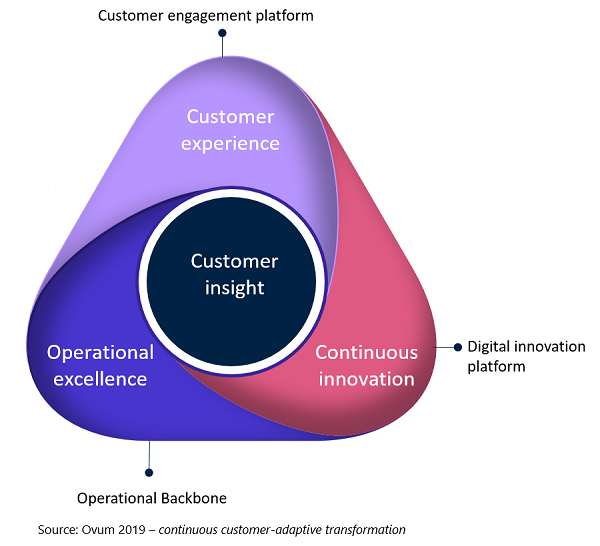The latest figures from Ovum’s global research into omnichannel customer engagement show businesses appear to be going backwards in meeting customer expectations, despite efforts to move forward.
Consider the data we’ve compiled over the last three years from approximately 5,000 enterprises. In 2017, only 7% believed they had cracked omnichannel customer engagement. In 2018, this rose to 10%. However, the latest figures from Ovum’s Global ICT Enterprise Insights study showed a drop, to 9%. Worse, the percentage with advanced deployments dropped by 5% from 24% in 2018 to 19% in 2019. Why the sudden fall, and is this critical transformation initiative really going backwards?
Realizing the Enormity of the Challenge
Our view is that many enterprises have been staring at a false summit regarding omnichannel customer engagement. It is not about simply adding more digital channels; the challenge is far more complex than that. Nor is it simply about adopting modern front-office systems. What is required is a massive cultural shift to center the organization on the customer and to deliver relevance throughout every customer journey. That requires more than the 360-degree transactional view of the customer; it demands contextual intelligence to really understand what customers are trying to achieve and the ability to support them every step of the way.
While modern technologies and advances in artificial intelligence (AI) and automation hold tremendous promise, operational, departmental, and systems silos allied to fragmented data must be addressed first. Omnichannel is not a bolt on, but an organization-wide transformation. It is fueled by trustworthy data from multiple internal sources, from front-office engagement systems such as commerce, marketing, sales, and service all the way to the back office and supply side of the business. Yesterday’s operational value chain that provided a sequential approach to sourcing, production, marketing, and selling of products and services and then outbound to the customer, with some post-delivery service, is back-to-front.
Time to Ditch the Received Wisdom of the Analog Era?
In the mid-1990s, business strategists Fred Wiersema and Michael Treacy published their book, “The Disciplines of Market Leaders,” which became part of the staple diet of most business schools and received wisdom for the current crop of CEOs who have trodden the MBA route to the C-suite. Based on their extensive research, Wiersema and Treacy concluded that to win in the marketplace any business must excel at one of three value disciplines:
- Product leadership — so that customers beat a path to the door
- Operational excellence — efficient production at lowest cost
- Customer intimacy — segmenting customers and adapting offers to fit their requirements
While each has its advantage, they counselled against trying to be good at all three as doing so would dilute focus and lead to being average to poor across the board. However, as the authors pointed out, once one of the disciplines had been mastered it was possible to then graft on another. The example they gave was Toyota, which became operationally excellent and then became a market leader in economical but high-quality vehicles.
On the face of it, their advice made a great deal of sense at a time when it was fine to take many years to evolve and in the pre-Internet analog era. But the speed of change is accelerating so it’s time for a more integrated strategy for the digital era.
New Set of Integrated Digital Value Disciplines Needed
In this digital era, speed matters more than ever. For any enterprise to survive, let alone thrive, it must learn to sense, respond, and adapt at an increasingly rapid pace to keep up with the evermore demanding and entitled customer.
To pull off this remarkable feat, the enterprise must revolve around its customers and gather and use customer insight to drive its transformation. Operational excellence leads to reliability, which is the foundation for a basic level of customer satisfaction. Gathering customer insight via techniques such as intelligent process mining can help identify sources of friction that negatively impact the customer. But to thrive any organization must deliver a positive customer experience, and that often relies on real-time contextual customer insight to trigger the most relevant response. Enterprises must also continuously refresh value, and that can be in the form of innovative products and services, augmented customer experiences, or even new business models that create new sources of value for customers and the business. Each of the three digital value disciplines mutually reinforce each other. Insights gained from the customer experience may generate ideas for innovation.
To support this highly dynamic and adaptive digital environment, we are seeing the emergence of digital platforms. Operational excellence is supported by an operational backbone of highly connected systems that cover the operational value chain or network. Advanced CRM applications have been steadily evolving into customer engagement platforms that include commerce, marketing, sales, service, field service applications, plus collaboration, AI, and automation tools. Continuous innovation may also be supported by a digital innovation platform, where Lego-like building blocks of code can be developed, tested, and deployed via APIs to enhance operations or the customer experience. Such a platform can be extended to an ecosystem of developers a firm may wish to attract, to rapidly spin up new capabilities or extend existing capabilities rapidly.
By taking a holistic approach to customers, and embracing these new digital disciplines, enterprises can accelerate transformation and push forward the ability to deliver a mutually rewarding omnichannel customer experience.











